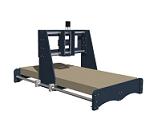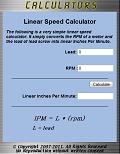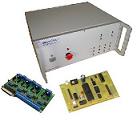Stepper Vs. Servo Motors
| Characteristics |
Servo Motor (DC Brushed |
Stepper (Hybrid) |
|
| Cost |
The cost for a servo motor and servo motor system is higher than that of a stepper motor system with equal power rating. |
This feature would have to go to stepper motors. Steppers are generally cheaper than servo motors that have the same power rating. |
|
| Versatility |
Servo motors are very versatile in their use for automation and CNC applications. |
Stepper motors are also very versatile in their use for automation and CNC applications. Because of their simplicity stepper motors may be found on anything from printers to clocks. |
|
| Reliability |
This is a toss up because it depends on the environment and how well the motor is protected. |
The stepper takes this category only because it does not require an encoder which may fail. |
|
| Frame Sizes |
Servo motors are availible in a wide variety of frame sizes, from small to large motors capable of running huge machines. Many of the motors come in NEMA standard sized. |
Stepper motors do not have as many size selections as servo motors in the large sizes. However stepper motors may still be found in a variety of NEMA frame sizes. |
|
| Setup Complexity |
Servo motors require tuning of the (PID) closed loop variable circuit to obtain correct motor function. |
Stepper motors are almost plug-and-play. They require only the motor wires to be wired to the stepper motor driver. |
|
| Motor Life |
The brushes on servo motors must be replaced every 2000 hours of operation. Also encoders may need replacing. |
The bearing on stepper motors are the only wearing parts. That gives stepper motors a slight edge on life. |
|
| Low Speed High Torque |
Servo motors will do fine with low speed applications given low friction and the correct gear ratio |
Stepper motors provide most torque at low speed (RPM). |
|
| High speed High Torque |
Servo motors maintain their rated torque to about 90% of their no load RPM. |
Stepper motors lose up to 80% of their maximum torque at 90% of their maximum RPM. |
|
| Repeatability |
Servo motors can have very good repeatability if setup correctly. The encoder quality can also play into repeatability. |
Because of the way stepper motors are constructed and operate they have very good repeatability with little or no tuning required. |
|
| Overload Safety |
Servo motors may malfunction if overloaded mechanically. |
Stepper motors are unlikely to be damages by mechanical overload. |
|
| Power to Weight/Size ratio |
Servo motors have an excellent power to weight ratio given their efficiency. |
Stepper motors are less efficient than servo motors which usually means a smaller power to weight/size ratio. |
|
| Efficiency |
Servo motors are very efficient. Yielding 80-90% efficiency given light loads. |
Stepper motors consume a lot of power given their output, much of which is converted to heat. Stepper motors are usually about 70% efficient but this has some to do with the stepper driver. |
|
| Flexibility in motor resolution |
Since the encoder on a servo motor determines the motor resolution servos have a wide range of resolutions available. |
Stepper motors usually have 1.8 or 0.9 degree resolution. However thanks to micro-stepping steppers can obtain higher resolutions. This is up to the driver and not the motor. |
|
| Torque to Inertia Ratio |
Servo motors are very capable of accelerating loads. |
Stepper motors are also capable of accelerating loads but not as well as servo motors. Stepper motors may stall and skip steps if the motor is not powerful enough. |
|
| Least Heat production |
Since the current draw of a servo motor is proportional to the load applied, heat production is very low. |
Stepper motors draw excess current regardless of load. The excess power is dissipated as heat. |
|
| Reserve Power and Torque |
A servo motor can supply about 200% of the continuous power for short periods. |
Stepper motors do not have reserve power. However stepper motors can brake very well. |
|
| Noise |
Servo motors produce very little noise. |
Stepper motors produce a slight hum due to the control process. However a high quality driver will decrease the noise level. |
|
| Resonance and Vibration |
Servo motors do not vibrate or have resonance issues. |
Stepper motors vibrate slightly and have some resonance issues because of how the stepper motor operates. |
|
| Availability |
Servo motors are not as readily available to the masses as are stepper motors. |
Stepper motors are far easier to find than quality servo motors. |
|
| Motor Simplicity |
Servo motors are more mechanically complex due to their internal parts and the external encoders. |
Stepper motors are very simple in design with no designed consumable parts. |
|
| Direct Drive Capability |
Servo motors usually require more gearing ratios due to their high RPM. It is very rare to see a direct drive servo motor setup. |
Stepper motors will work fine in direct drive mode. Many people simple use a motor couple and attach the motor shaft directly to the leadscrew or ballscrew. |
|
| Power Range |
Because servo motors are available in DC and AC servo motors have a very wide power availability range. |
The power availability range for stepper motors is not that of servo motors. |
|








